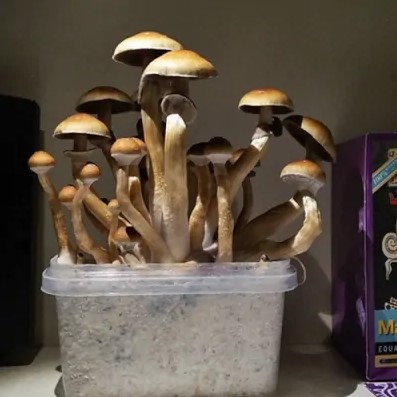psilocybin
Examining the Classification of Psilocybe Cubensis
Introduction
Psilocybe cubensis, commonly known as the “Magic Mushroom”, is a species of psychedelic mushroom that belongs to the fungi kingdom. This species can be found in tropical and subtropical environments around the world, particularly in humid areas with temperatures between 21-30°C. It has been classified into several distinct genera and subspecies based on their appearance and psychoactive properties. Common classification systems include taxonomy, which looks at its family name; habitat requirements; morphology or physical characteristics; ecology; and effects when consumed.
Taxonomy
The family Psilocybe cubensis belongs to is the Strophariaceae, a large group of fungi found in tropical and subtropical regions. This species is also known as the “Golden Teacher” due to its yellowish-brown spore print. It has been classified into several distinct genera based on their physical characteristics such as cap shape, stem length, cap color, and gill structure. The most common genera are Panaeolus (the Blue Meanies), Copelandia (the Hawaiian strain), Gymnopilus (Spectabilis) and Pluteus.
Psilocybe cubensis can be further divided into many subspecies depending on where they grow in the world. For example, there are Mexican strains that have different properties than those from Thailand or Cambodia. These differences may include taste, smell and even potency levels when consumed orally or smoked. The best way to identify these subspecies is through macroscopic observation including caps colors and shapes along with spore prints using microscopes or magnifying lenses for viewing spores under high magnification power .
When it comes to ecology of this species it prefers warm temperatures between 21-30°C with moderate humidity levels but still prefers humid environments like cow pastures near riverside habitats which provide plenty of organic matter for fungus growth; however some specimens can survive harsh winter conditions if buried underground during cooler months while others prefer partial shade areas close to wooded areas that offer shelter from strong winds.. In terms of effects when consumed this mushroom produces mild hallucinogenic effects similar to LSD usually lasting 4-6 hours depending upon strength taken by user making it popular among recreational users seeking out an altered state consciousness without too intense psychedelic experience associated with other more potent substances like DMT or Psilocybin mushrooms which produce stronger psychoactive effects sometimes leading to long term psychological alterations if used carelessly without proper supervision by trained professionals familiar with handling psychedelics responsibly
Habitat
The natural habitat of Psilocybe cubensis is highly dependent on various factors. This species typically grows in tropical and subtropical climates, ideally at temperatures between 21-30°C with moderate humidity levels. It also prefers humid environments like cow pastures near riverside habitats which provide plenty of organic matter for fungus growth; however some specimens can survive harsh winter conditions if buried underground during cooler months while others prefer partial shade areas close to wooded areas that offer shelter from strong winds.
In addition to climate, the distribution patterns of this species are largely influenced by soil composition and moisture levels as well as availability of food sources such as decaying plant material or animal feces that provide essential nutrients for its growth. The presence of other fungi in the area may also affect its distribution since Psilocybe cubensis has been known to compete with other fungal organisms for resources within a given ecosystem. Furthermore, human activities such as deforestation or overgrazing can significantly reduce the available habitat suitable for this species’ survival thus leading to local extinctions where it once thrived.
Appearance and Morphology
Psilocybe cubensis is an iconic species in the world of psychedelics due to its wide distribution and ease of cultivation. It is a wood-loving fungus with a characteristic blue or purplish hue on its cap that can range from light yellow to dark brown in color. The stem is typically around 3-7 cm long, slender but tough, whitish at the base and slightly darker towards the top where it gives way to a broad gill structure bearing spore prints in shades of purple or rusty brown depending on maturity.
The variations between each subspecies of Psilocybe cubensis depend largely on their geographical location as well as environmental conditions such as temperature, humidity and soil type. For example, strains found near Mexico tend to be more potent than those located further away from this region while others seem to have higher levels of psilocin compared to other regions around the world. Furthermore, some subspecies are known for their unique visual effects when consumed such as increased brightness and colors appearing more vivid than normal while others may induce intense spiritual experiences accompanied by powerful hallucinations not seen with other varieties.
Ecology and Habitat
Psilocybe cubensis is a species of psychedelic mushroom that prefers humid, warm environments with temperatures between 21-30°C. This species can be found in tropical and subtropical regions around the world, particularly in cow pastures near riverside habitats which provide plenty of organic matter for fungus growth. Other factors influencing its growth include soil composition and moisture levels as well as availability of food sources such as decaying plant material or animal feces that provide essential nutrients for its survival. The presence of other fungi in the area may also affect its distribution since Psilocybe cubensis has been known to compete with other fungal organisms for resources within a given ecosystem. Furthermore, human activities such as deforestation or overgrazing can significantly reduce the available habitat suitable for this species’ survival thus leading to local extinctions where it once thrived.
In order to cultivate Psilocybe cubensis successfully at home one must maintain ideal conditions similar to those found naturally in nature which includes providing adequate light and ventilation along with proper nutrition through composting methods like using horse manure mixed with wheat straw or rice husks among many others depending on what is locally available; however some specimens have been known to survive harsh winter conditions if buried underground during cooler months while others prefer partial shade areas close to wooded areas that offer shelter from strong winds. Ultimately maintaining an optimal environment is key when cultivating any type of mushroom including Psilocybe cubensis so one should research thoroughly before attempting any form of cultivation whether indoors or outdoors.
The Psychedelic Experience
The effects of consuming Psilocybe cubensis can vary greatly depending on the dose and individual’s body chemistry. Generally, users report feeling relaxed and tranquil as well as more connected to their environment with enhanced visual acuity, creativity, and emotional empathy. These effects are usually accompanied by a distinct sense of euphoria that may last up to six hours or longer in higher doses. At the same time, some people have reported mild auditory distortions such as hearing colors or music from within their own minds while others experience intense visuals including bright shapes or patterns that seem to swirl around them when they close their eyes.
In terms of sensory experiences, many describe an overwhelming feeling of joy along with increased awareness of color and sound sensations which can often become exaggerated in intensity over time; however this is not always true for everyone since each person’s reaction is highly dependent upon a variety of factors such as dosage taken, set & setting (the mood and environment before taking it) among other things. Furthermore, some individuals may find themselves laughing uncontrollably at times while others may enter into deep introspective states leading towards spiritual revelations during the course of the trip itself making it difficult to predict just what kind of experience one will have when ingesting psilocybin mushrooms like Psilocybe cubensis due its highly variable nature based on all these different inputs combined together into a singular momentary experience unlike anything else found naturally in our world today!
Conclusion
In conclusion, Psilocybe cubensis is an iconic species of psychedelic mushroom that can be found in tropical and subtropical regions around the world. Its habitat requirements are largely influenced by climate, soil composition and moisture levels as well as availability of food sources such as decaying plant material or animal feces for essential nutrients. When cultivated responsibly indoors or outdoors with ideal conditions similar to those found naturally in nature; this fungus has been known to produce powerful psychoactive effects ranging from relaxed states of euphoria to intense hallucinations depending on dosage taken and individual body chemistry. Furthermore, due to its wide distribution and ease of cultivation, it is a highly sought after organism among amateur mycologists and psychonauts alike making it one of the most popular mushrooms today!

